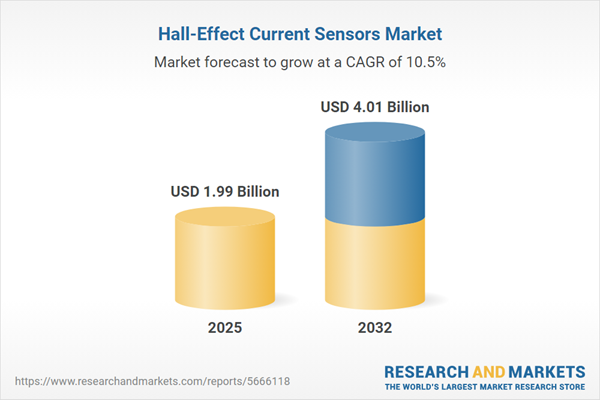Speak directly to the analyst to clarify any post sales queries you may have.
Hall-effect current sensors are increasingly vital to advanced electrical systems, enabling high-precision, non-intrusive current measurement for industries navigating rapid technology change, evolving regulation, and global supply chain complexity.
Market Snapshot: Hall-Effect Current Sensors Market
The Hall-effect current sensors market grew from USD 1.80 billion in 2024 to USD 1.99 billion in 2025. It is expected to continue growing at a CAGR of 10.51%, reaching USD 4.01 billion by 2032. This expansion is supported by rising adoption in automotive electrification, renewables, industrial automation, and evolving infrastructure needs across key economies.
Scope & Segmentation: In-Depth Coverage of Key Hall-Effect Current Sensor Market Domains
- Product Type: Closed loop and open loop Hall-effect sensors targeting different balance points between linearity, response time, and cost efficiency.
- Output Type: Analog options for compatibility with legacy systems and continuous signals; digital variants with onboard processing for enhanced integration and self-diagnostics.
- End User: Applications spanning automotive (conventional and electric vehicles), consumer electronics (computers, home appliances, smartphones), industrial (automation, control systems), power electronics (converters, inverters), and renewable energy markets (hydro, solar, wind).
- Current Range: Segments encompassing less than 50 A for compact electronics, 50–100 A for mainstream applications, 100–500 A for industrial scale, and greater than 500 A for high-demand use cases.
- Geographic Regions: Market analysis includes Americas (United States, Canada, Mexico, Brazil, Argentina, Chile, Colombia, Peru), Europe, Middle East, and Africa (UK, Germany, France, Russia, Italy, Spain, Netherlands, Sweden, Poland, Switzerland, UAE, Saudi Arabia, Qatar, Turkey, Israel, South Africa, Nigeria, Egypt, Kenya), and Asia-Pacific (China, India, Japan, Australia, South Korea, Indonesia, Thailand, Malaysia, Singapore, Taiwan).
- Leading Companies: Examined in detail are Allegro MicroSystems, Infineon Technologies, Melexis, STMicroelectronics, Texas Instruments, Honeywell International, TDK Corporation, LEM Holding, ROHM, and Sensata Technologies.
Key Takeaways for Senior Decision-Makers
- Hall-effect current sensors are fundamental to modernizing electrical measurement and control with non-contact, accurate current sensing suitable for both rugged and miniaturized environments.
- The transition from component-centric to platform-oriented solutions is enabling integration with microcontrollers and programmable logic for lower system complexity, boosting deployment across automotive, renewables, and next-gen electronics.
- Closed loop sensors are gaining preference in applications demanding high linearity and rapid diagnostics, while open loop models remain attractive where cost and simplicity are essential.
- Investments in material science and form factor miniaturization are enhancing sensor performance, enabling adaptation to constraints seen in edge devices and compact converters.
- Collaboration across semiconductor vendors, OEMs, and software developers is fostering end-to-end data integrity, cybersecurity, and predictive maintenance capabilities in sensor modules.
- Regional supply chain and regulatory variations are driving tailored strategies, from North American electrification to Asia-Pacific’s volume manufacturing and Europe’s compliance focus.
Tariff Impact: Navigating Supply Chain Challenges and Adaptive Responses
The 2025 United States tariffs on imported electronics and sensor inputs have introduced cost pressures and supply risks for Hall-effect current sensor stakeholders. Manufacturers are undertaking supplier renegotiations, material substitution, and regional assembly relocation to mitigate tariff effects. These measures are furthering dual sourcing and agile procurement, while catalyzing closer OEM-supplier collaboration and stimulating design innovation that reduces import dependency. Industry engagement with government bodies reflects a coordinated response to optimize supply continuity and regulatory alignment.
Primary Keyword Focus: Hall-Effect Current Sensors Market
Methodology & Data Sources
This analysis is grounded in a blend of qualitative and quantitative research. It includes secondary review of technical literature, patents, and market data, as well as primary interviews with engineers, system integrators, and procurement professionals. Onsite observations at manufacturing facilities supplemented performance validation. Data triangulation and expert panel reviews ensured robust insight and relevance to industry priorities.
Why This Report Matters
- Enables strategic planning by providing actionable segmentation analytics across end user, technology, and region.
- Delivers competitive intelligence and best practices for building resilient, agile supply and innovation strategies.
Decision-makers gain clarity on market inflection points and actionable levers to drive growth, mitigate risk, and advance technological leadership in current sensing.
Conclusion
Hall-effect current sensors are redefining measurement and control in power electronics, mobility, and automation. Senior leaders equipped with these insights can confidently steer strategy amid technology shifts and new regulatory realities.
Additional Product Information:
- Purchase of this report includes 1 year online access with quarterly updates.
- This report can be updated on request. Please contact our Customer Experience team using the Ask a Question widget on our website.
Table of Contents
3. Executive Summary
4. Market Overview
7. Cumulative Impact of Artificial Intelligence 2025
Companies Mentioned
The companies profiled in this Hall-Effect Current Sensors market report include:- Allegro MicroSystems, LLC
- Infineon Technologies AG
- Melexis N.V.
- STMicroelectronics N.V.
- Texas Instruments Incorporated
- Honeywell International Inc.
- TDK Corporation
- LEM Holding SA
- ROHM Co., Ltd.
- Sensata Technologies Holding PLC
Table Information
| Report Attribute | Details |
|---|---|
| No. of Pages | 197 |
| Published | November 2025 |
| Forecast Period | 2025 - 2032 |
| Estimated Market Value ( USD | $ 1.99 Billion |
| Forecasted Market Value ( USD | $ 4.01 Billion |
| Compound Annual Growth Rate | 10.5% |
| Regions Covered | Global |
| No. of Companies Mentioned | 11 |









